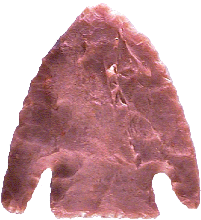

Point Type: CASTROVILLE
Also See: Andice, Calf Creek, Lange, Marcos, Marshall, Mehlville, Williams
Location: Midwestern to Southeastern United States
Associated Dates:
4000 - 1500 B.P. - Late Archaic to Woodland
Morphology: Corner
Notched
General Description: The Castroville is a medium to large sized, broad, triangular, corner notched point with an expanding base and prominent drooping winged barbs that can reach all the way to the basal edge which give the impression of a basal notched form. The blade edges are mildly excurvate to straight in outline. The shoulders may be weak and the downward pointing barbs totally missing on reworked specimens but are usually strong with well-defined barbs. The stem is broad and may be straight or expand towards the base. The basal edge is usually straight but may be slightly convex.
The Castroville is primarily a central Texas point which occurs in the Edwards Plateau region with less frequency in adjacent areas of Texas. It can resemble both the Marcos and Williams points. Heavily reworked specimens can cause type identification problems with these three types however here are some clues. When the stem expands near the basal edge it can be confused with the Williams type, however the barbs on the Williams type are not as strong or prominent as they tend to be on the Castroville. The Marcos point has notches that are chipped inward just above the base while the Castroville has notches that are cut upward from the base.
The Castroville can range from 45 mm to 85 mm in length based on a small sample size number of specimens. The width can range from 30 mm to 60 mm. The stem width ranges from 20 mm to 30 mm. The stem length ranges from 10 mm to 16 mm. The point was named in 1947 by J. Charles Kelley for examples which were found at the Lehmann Rock Shelter in Castroville, Texas. The point was originally called the "Castroville Convex Base" and described by E. O. Miller and E. B. Jelks in 1952. The name was shortened to "Castroville" by D. A. Suhm, A. D. Krieger and Jelks in 1954.
About the Point Above: The Castroville blade pictured at the top of this page was once in the Wayne Rogers collection, Houston, Texas. The point is made from a glossy brown colored flint that has small light tan and white inclusions. The edges of the blade show fine bifacial retouch and the distal end has been reworked many times. This blade has the straight base outline and exhibits the drooping barbs. Overall, the point measures 53 mm in length, is 47 mm wide across the barbs, and is 5.5 mm thick in mid blade. The stem is 11 mm long and mildly expands to 26 mm wide. The stem thickness is 4 mm. The basal edge shows some minor grinding as do the stem edges. Catalog Number 37-50-U
References: Davis, Overstreet, Perino (1), Turner & Hester
© Copyright 1997 - 2009 LITHICS-Net WWW.LITHICSNET.COM
Use your Browser's BACK Button to return to the LITHICS-Net Index.